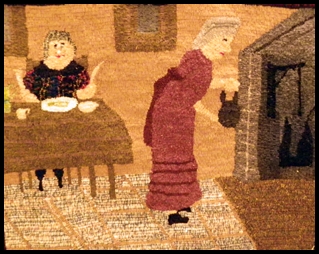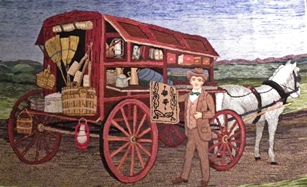The North American Gallery houses rugs and exhibits from both Canada and the United States. Some of the names you will see in this large room are Burnham, Waldoboro, Mrs. Harry King, Pearl McGown, Louise Hunter Zeiser, Frost and Priscilla Turner.
Coming in 2016 is a new Pearl McGown exhibit - stay tuned for more information!
New to the gallery this year is the beautiful, circular Tiger Rug hooked by Wilma Hill of Fort Smith, Arkansas.
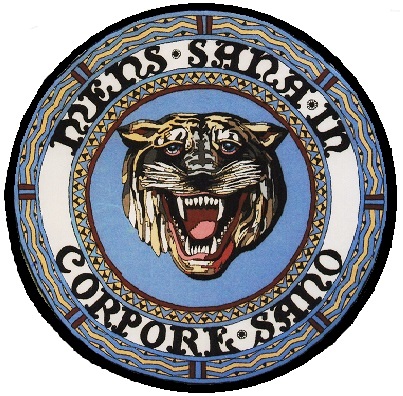 Tiger Rug by Wilma Hill
Tiger Rug by Wilma Hill
The Story of the Louisiana State University Tiger Rug
Huey P. Long, former governor of the state of Louisiana, had the goal of making the Louisiana State University one of the leading schools in the United States. In his attempt to do this, he commissioned a number of artists and architectural additions to the campus in Baton Rouge. In 1931, a new student union building was built that currently houses classrooms and offices, and is called the Huey P. Long Field House. In the foyer is a large and impressive floor mosaic consisting of the head of a tiger, bordered by Latin inscription “Mens sana in corpore sano” “sound mind in sound body”.
The mascot for Louisiana State University’s (LSU) proud and highly competitive athletic teams is the tiger. The “Tigers” nickname and logo was chosen to honor two Louisiana brigades that fought so fiercely during the Civil War. They became known as the “Louisiana Tigers”. Today spirit remains strong. Get in the way of the fighting faithful and you’ll be “tiger bait”.
For the rug hooking artist, it’s personal. Wilma Hill’s husband taught at LSU for thirty years. Every day he walked across a seven-foot round floor mosaic of a tiger’s head, surrounded by a Latin inscription and colorful geometric border. Both Wilma and her husband would remark about the artistic talent of the person who created the work and about how well its rich earthy colors would look hooked into a rug using the original as a pattern.
The challenge became a dare, and one year when the students were away for Mardi Gras holiday Wilma and her husband traced the pattern and transferred it to a monk’s cloth backing. Then the fun of finding the fabric to hook with began.
Wilma learned to hook rugs in 1973 and became a certified McGown teacher at the Southeastern Teachers’ Workshop in Jekyll Island, Georgia in 1981. After getting her McGown teachers certification Wilma began a McGown chapter known as the Baton Rouge Rugger Roux. The group was very active giving demonstrations and educating others about rug hooking.
Wilma Hill donated her rug to the Hooked Rug Museum of North America in 2015, for historic preservation. Wilma now lives in Fort Smith, Arkansas.
***************
Upon entering the gallery the wall in front and directly to your right is covered with hooked pieces from the Frost Collection.
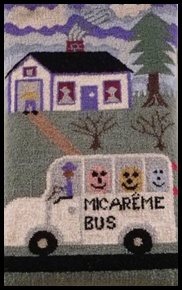
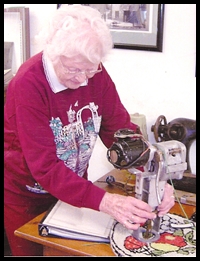
Most rug hookers have never heard of the Priscilla Turner Guild; it's existence is little known, like most of early rug hooking history. HRMNA has now completed a study of this unique guild and with difficulty have obtained one of her rugs. Interviews were conducted with Leota Seward the last surviving Guild member, who at 97 years of age had her picture taken with her 15 pound rug hook!
